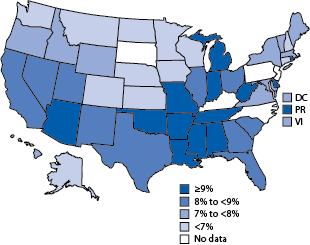Fact Sheet
This website is archived for historical purposes and is no longer being maintained or updated.
CDC Report: Mental Illness Surveillance Among Adults in the United States
The economic burden of mental illness in the United States is substantial—about $300 billion in 2002. Mental illness is also associated with chronic medical diseases such as cardiovascular disease, diabetes, and obesity. Mental illness surveillance is a critically important part of disease prevention and control.
What is mental illness?
The term mental illness refers collectively to all diagnosable mental disorders. Effects of the illness include sustained abnormal alterations in thinking, mood, or behavior associated with distress and impaired functioning. The effects of mental illnesses include disruptions of daily function; incapacitating personal, social, and occupational impairment; and premature death. The most common mental illnesses in adults are anxiety and mood disorders.
How widespread is mental illness?
According to the World Health Organization, mental illness results in more disability in developed countries than any other group of illnesses, including cancer and heart disease. Other published studies report that about 25% of all U.S. adults have a mental illness and that nearly 50% of U.S. adults will develop at least one mental illness during their lifetime.
Where in the United States is the level of mental illness highest?
Depression estimates generally are highest in the Southeastern states (e.g., 13.7% in Mississippi and West Virginia vs. 4.3% in North Dakota).

FIGURE 1. Prevalence of current depression among adults aged ≥18 years, by state quartile — Behavioral Risk Factor Surveillance System, United States, 2006
"We know that mental illness is an important public health problem in itself and is also associated with chronic medical diseases such as cardiovascular disease, diabetes, obesity, and cancer. The report's findings indicate that we need to expand surveillance activities that monitor levels of mental illness in the United States in order to strengthen our prevention efforts."
—Ileana Arias, Ph.D., Principle Deputy Director,
Centers for Disease Control and Prevention (CDC)
What is mental illness surveillance?
Public health surveillance is the ongoing and systematic collection, analysis, interpretation, and dissemination of data used to develop public health interventions that reduce morbidity and mortality and improve health. Surveillance for a particular condition—such as mental illness—might depend either on collecting new data or using data obtained from existing health information systems.
Why is monitoring mental illness important?
Surveillance activities that monitor mental illness are essential because mental illness is a significant public health problem. For example,
- according to the World Health Organization, mental illnesses account for more disability in developed countries than any other group of illnesses, including cancer and heart disease;
- published studies report that about 25% of all U.S. adults have a mental illness and that nearly 50% of U.S. adults will develop at least one mental illness during their lifetime;
- mental illness is associated with increased occurrence of chronic diseases such as cardiovascular disease, diabetes, obesity, asthma, epilepsy, and cancer;
- mental illness is associated with lower use of medical care, reduced adherence to treatment therapies for chronic diseases, and higher risks of adverse health outcomes;
- mental illness is associated with use of tobacco products and abuse of alcohol;
- rates for both intentional (e.g., homicide, suicide) and unintentional (e.g., motor vehicle) injuries are 2 to 6 times higher among people with a mental illness than in the population overall;
- population-based surveys and surveillance systems provide much of the evidence needed to guide effective mental health promotion, mental illness prevention, and treatment programs;
- monitoring mental illness is an important way to provide appropriate organizations the data they need to assess the need for mental and behavioral health services and to inform the provision of those services;
- many mental illnesses can be managed successfully, and increasing access to and use of mental health treatment services could substantially reduce the associated morbidity;
- many chronic illnesses are associated with mental illnesses, and it's been shown that treatment of mental illnesses associated with chronic diseases can reduce the effects of both and support better outcomes; and
- CDC surveillance systems provide several types of mental health information, such as estimates of the prevalence of diagnosed mental illness from self-report or recorded diagnosis, estimates of the prevalence of symptoms associated with mental illness, and estimates of the effect of mental illness on health and well-being.
How is CDC involved in monitoring mental illness?
CDC collects certain mental health data about the U.S. adult population in various ways, including:
- Population Surveys
- State-specific Behavioral Risk Factor Surveillance System (BRFSS)
- National Health Interview Survey (NHIS)
- National Health and Nutrition Examination Survey (NHANES)
- Pregnancy Risk Assessment Monitoring System (PRAMS)
- Health Care Surveys
- National Ambulatory Medical Care Survey (NAMCS)
- National Hospital Ambulatory Medical Care Survey (NHAMCS)
- National Hospital Discharge Survey (NHDS)
- National Nursing Home Survey (NNHS).
On September 2, 2011, CDC released Mental Illness Surveillance Among Adults in the United States, an MMWR that summarized current data from the above surveillance and information systems.
What are the report authors' conclusions?
The authors note that, currently, no surveillance efforts at the national or state level are directed toward documenting anxiety disorders. However, anxiety disorders are as common in the population as depression. Moreover, anxiety disorders have similar characteristics to depression in that they
- can impose as much impairment as depression,
- are also related to the stress response system of the body,
- have health impact similar to depression, and
- are often found to coexist with the same chronic medical conditions found in those who suffer from depression.
The authors stress the importance of initiating national-level anxiety disorder surveillance activities to help guide public health policy. They also call for anxiety disorder surveillance to be conducted at the state and local levels so that public health services addressing this condition can be designed, implemented, and evaluated.
- Page last reviewed: December 2, 2011 (archived document)
- Content source:


 ShareCompartir
ShareCompartir